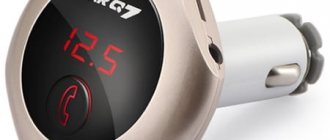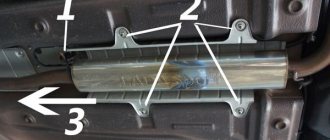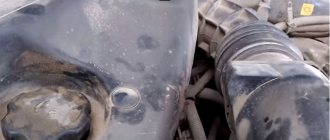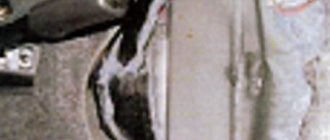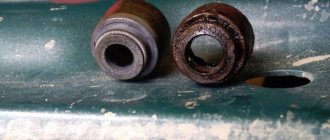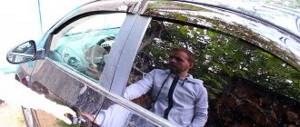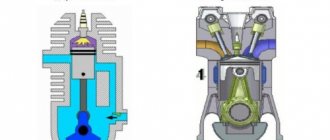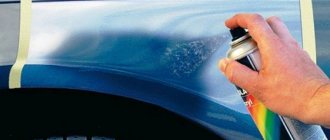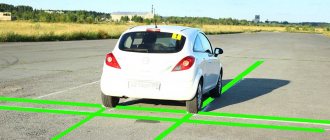Sooner or later, any car enthusiast will have to repair this body part. In case of significant damage, threshold welding is used. But more often, under the influence of corrosion, unsightly rusty areas with through holes form on the surface. Applying patches to them is labor-intensive and not accessible to everyone, so it is useful to learn how to repair holes in a car sill without welding.
- Fixed. They are welded to the body and form a single whole with it. They look like a rigid structure.
- Removable ones, unlike the previous ones, are fastened with self-tapping screws or bolts. Used as additional body protection or an auxiliary step.
- Power structures are installed on jeeps with a frame structure. Fastened by welding or bolts. They are larger in size than those of cars with a monocoque body.
During repairs, design features are taken into account. Thresholds can be plastic, metal, chrome, or illuminated.
Types of thresholds and their tasks
Before you start repairing car thresholds with your own hands, you need to understand what they are and what they are used for.
Thresholds are needed to:
- protect the car from scratches, deformations and other damage;
- help the driver and passengers get into and out of the car;
- prevent destructive processes on the body;
- visually complement the appearance of the car.
Another point is which threshold needs to be repaired.
There are several varieties and classifications.
Based on the material, they can be divided into 2 categories:
- Plastic
. They are more often found on budget cars. Often deformed, cracked, broken. Not the most reliable. Can be restored without welding in a garage; - Metal
. Not only are they subject to deformation, but also to corrosion.
Design features should also be taken into account.
There are also 2 subtypes here:
- Removable
. They differ in that they can be removed from the car. This provides more convenience during repairs. They are removed by unscrewing special screws or other fasteners; - Fixed
. They are a part, a continuation of the body. They complicate the work, since repairs have to be done directly on the car.
You can repair the thresholds yourself. You need to determine what problem you are facing, how complex it is, and apply the appropriate method.
Methods for solving the problem
There are three options for solving the problem. The first of them is to carry out anti-corrosion treatment of the body in a timely manner.
Another method to get rid of rust on a body is to replace the entire load-bearing part. But all this will cost a lot of money. After all, you will have to not only purchase a body, but then also solve problems with government agencies, since, after replacing the load-bearing part, we get, in fact, a new car. In general, this option is not suitable for everyone.
The third way to solve problems with emerging rust is to cut out the areas damaged by corrosion and then seal everything using a welding machine.
This option is considered quite common due to its comparative cheapness, and with the right approach, traces of body restoration are not noticeable. In this case, no problems with the organs will arise, since the car will have a “native” body.
A positive aspect of carrying out body restoration work using welding is the ability to perform it in a garage, since this does not require much equipment, and you can learn how to operate a welding machine in a couple of hours using scrap materials.
The main problem in welding a body with your own hands is that the thickness of the metal of different components of the load-bearing part is different and varies from 0.7 to 3 mm.
In addition, sometimes it is necessary to weld metal elements of different thicknesses together. If the welding machine is set up incorrectly, the metal can easily be burned through, that is, all work, in fact, will be in vain.
Plastic thresholds
Let's start with the plastic elements. It's not that difficult with them. But you will need to use fiberglass (fiberglass), as well as epoxy resin.
A worthy method for restoration, with which you can return an element to its former appearance. This is no more difficult than repairing a plastic bumper, for example.
In the case of plastic, you need to do the following:
- Remove the threshold. Plastic ones are mostly removable. Next, you need to carefully inspect the part and check where there is damage;
- Threshold elements that literally hang down are easier to break off or carefully cut off with pliers;
- Clean the surface with sandpaper and degrease;
- After this, apply a layer of heated resin, attach glass mat to it and fix it. Usually several layers are needed;
- It is important that the fiberglass extends beyond the damaged area by at least 3-4 cm on each side, along the entire perimeter of the threshold defect;
- Then another layer of resin is applied, and again fiberglass;
- Each subsequent layer is applied only after the previous one has completely hardened. On average, this takes from 1 to 4 hours.
I note that the procedure is reminiscent of making a fiberglass bumper.
At the final stage, the excess is removed and processed with sandpaper. The threshold is coated with a primer and then painted.
Some people fill the interior space with foam. But this is already unnecessary, as for me. Although it’s easier to set the shape this way in case of major damage. If you don't agree, write in the comments.
What electrodes should be used to cook car sills?
Here are all the most useful and necessary things to choose electrodes for car thresholds. Anyone who has encountered it knows that the thickness of the metal varies from 0.7 to 1.5 mm depending on the make of the car. The steel itself for the production of the body is low-carbon and lends itself well to stamping. This is what we will build on.
What you need to know about the quality of welds. They carry a large load that comes from the car body while driving. It’s no secret that they don’t cook it whole, but only grab it in certain increments. It's different in different places. This stuck place itself should be ductile to fracture and not brittle. Even in severe frosts. Therefore, as for the welding process itself, it is necessary to pay attention to the thickness of the parts being welded. Of course, car welding is carried out semi-automatically or fully automatically, but since we have a need for welding with electrodes, we will find a way out. Select the current to the electrode on experimental pieces of the same thickness that you will cook. Otherwise you risk making holes. Perhaps OK brand electrodes will suit us.
For example, let's look at the OK 48.00 brand from ESAB.
As you can see, the idle speed is not great from only 24 volts. And the current strength is from 30 amperes. The type of current is both alternating and direct, but we need to do it with reverse polarity. This provides an advantage for good combustion of the electrode, and the metal being welded is less subject to heating. As a result of overheating, the part becomes deformed, which entails stress on the welding unit. Let's pay attention to the indicators of this brand; impact strength at minus 40 degrees gives a result of 70 J/cm2. Another advantage is the low hydrogen content in the weld metal, which is why it can be forged. A small drawback can be attributed to the short arc. Maintaining the distance is quite difficult.
If we take the OK 46.00 ESAB brand, then the maximum is minus 20 degrees of operation. Unlike its older brother OK 48.00 ESAB, the seams are more likely to burst. Since the impact strength at permissible low temperature is 34 J/cm2 and the relative elongation is 28%. What happens if it gets even colder? Personally, I didn't take any risks. What you can choose from the advantages is that they light easily. It’s easier to control if you’re new to this business.
And if we take the most affordable thing here in Russia, then MP-3A electrodes. For carbon steels up to 0.25%. Simply covering the electrode helps remove carbon gas from the weld pool and does not oversaturate it. They burn well without fading. But you need to cook carefully, even if they are with reverse polarity. It melts metal very quickly. As for impact strength, at zero it is 80 J/cm2. Well, at minus 20, no less than 34 J/cm2 GOST9467-75.
Using these examples, I tried to explain to you what factors influence when choosing electrodes.
As we see in these examples, the higher the requirements, the higher the quality of the seam, and the choice of what to cook is up to you. If anyone has little idea where to start, watch a video about welding. Books on welding Calcination of electrodes How to choose electrodes for welding.
Metal threshold with dents
Metal types of car thresholds rarely break and form holes. Most often, drivers encounter dents.
There are several ways to deal with them.
Let's consider those that can be used in garage conditions.
- Mallet or hammer
. If this is a removable option, then you can dismantle the threshold, arm yourself with a mallet, and restore the shape from the inside to the required geometry with precise blows. Then it is better to clean, apply a primer and paint the threshold; - Hood
. To extract small defects, you can use spotters or inertial pullers. There are special tools designed for such work. But they are expensive. And using it for personal use is not as beneficial as we would like; - Armature
. There is a more budget-friendly way. To do this, a piece of reinforcement is welded to the metal. After which, by pulling it towards you, the dent is corrected. Then the reinforcement is cut off, and the place where it is welded is cleaned and painted.
It is worth adding that I have repeatedly seen “miracle devices” from China that supposedly remove the most incredible dents. They work almost on suction cups and pull out metal.
Yes, they can bend thin metal or plastic. But it’s not worth talking about any serious work using them. Don't waste your money. It’s better to take a full-fledged spotter.
What are the defects?
According to the type of attachment to the supporting body, the thresholds are classified into removable, which are installed on the body with bolts, and non-removable. The elements are welded to the sidewall and provide the car structure with the necessary rigidity and reinforcement. Regardless of the type of installation, the elements suffer the same damage.
- Dents. Defects are formed from impacts with gravel, careless parking, or as a result of a minor accident. Mechanical damage from gravel damages the outer part of the underbody, wheel arches, and side members.
- Scratches, chips. The outer part is damaged. The defect does not affect driving safety; the appearance of the car suffers.
- Corrosion. Rust occurs due to natural wear and tear of the metal and due to improper processing or lack of anti-gravel protection. The degree of wear affects driving safety. If the non-removable threshold, as part of the power element of the body, rots, the overall geometry of the structure changes, the main components and assemblies are distorted: the engine and transmission elements.
Depending on the defect, the repair method is selected: welding, pulling out dents, straightening using spot welding, or sealing holes with adhesive.
Rusty metal thresholds
see also
Sheriff crankcase protection: product catalog, price, where to buy
Now a little about repairing rusty, rotten metal car sills.
In fact, repairing a rotten threshold is a dubious undertaking. Once the process is running, it is unlikely to be stopped. Over time, new outbreaks will appear.
The right solution in such a situation would be to replace the rotten body element.
But if the damage is small in area, it can be restored. You can't do without welding here.
The essence of the repair is to use a metal patch. The sequence will be like this:
- remove the threshold, if possible, and then prepare a place to work on the machine;
- remove any obviously loose areas of the rusty metal threshold;
- clean the element from rust, and what is not cleaned can be cut off with a grinder or other suitable tool;
- apply an anti-corrosion agent to the metal to prevent rust from quickly continuing to spread;
- attach a piece of metal for a patch;
- use a welding machine to weld it;
- clean, apply anti-corrosive, primers, use putty, and paint the threshold in the color of the body.
That's it, the work is completed.
